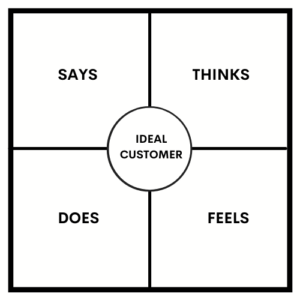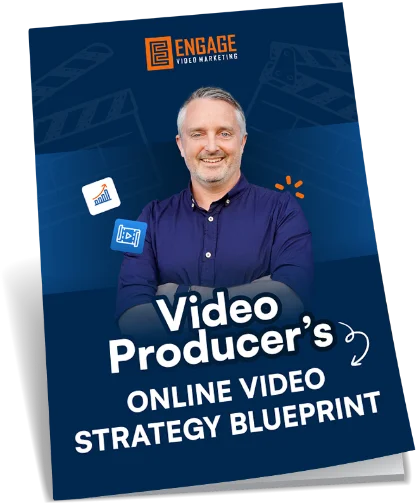I believe that one of the most underappreciated and sometimes underutilised concepts for effective marketing is empathy. And in particular, practising cognitive empathy, as a tool for crafting powerful marketing of any sort. In this article, I’m going to walk you through a super valuable exercise that you can do with your team or with your clients to inject more empathy into your marketing.
In my recent article, I shared what I believe to be the number one trait that all good video marketers need, and that is you guessed it – empathy. The idea of really understanding your ideal audience, stepping into their shoes, into their heads and their hearts, so that you can craft marketing that resonates with them and moves them to actually take the action that you need. Empathy really is a powerful tool and it is something that can be practised. In my video marketing agency, one of the ways that we work with our clients to develop more empathy when designing a marketing strategy is by creating something called an Empathy Map. I’m going to walk you through this exercise using one of our ideal customer avatars, as an example. Now, this empathy mapping exercise is something that’s best done either with your team if you’re working on your own marketing or in collaboration with a client, if you’re working more as an agency or a consultant.
Okay, so for this empathy mapping exercise, I’m using a virtual workspace created on Miro.com, but you can of course do this on a whiteboard or with post-it notes or in physical form as well, whatever floats your boat. I like working digitally so that’s how we’re going to work today.
So as you can see, the empathy map has a specific design or structure to it. In the middle here, you can see the four quadrants of the empathy map. What we have is our ideal customer in the middle, and I’ll get to that in a second. Then around that, we’re going to break down those four quadrants into what the customer says, what the customer thinks, what the customer does and what the customer feels. I’m going to use this as a framework to really spend some time brainstorming and understanding better what we know about our ideal customer that we’re trying to target in a marketing strategy in order, of course, to get more empathetic with that customer and what’s going to move them to take the action that we need them to with our marketing.
The ideal customer, obviously you need to have an understanding and go through a process before and really understanding your customer avatars, know who it is that you’re trying to reach with your marketing message for your business. Now, in this case, we’re going to, we’re going to do this for one of our customer advertise called Connected Chris. Now Connected Chris, just to give you a brief understanding of him, this is for our video marketing agency, he’s an ideal client for us. Connected Chris is a professional service provider is male 28. He’s in a relationship, he’s got no kids, around $92,000 income annually in his career. Chris is all about being connected to grow his client base and uses online platforms to connect. He’s regularly active on social media platforms and he likes to attend events and engage with articles that are about being ahead of the curve or ideas with technology and so on. So that’s a really brief understanding of our client avatar or one of our client avatars within my video marketing business. So let’s just keep Chris in mind as we go through this process here.
So we have Connected Chris, as our ideal customer in the middle. Obviously this is where you put your ideal audience in the middle or who it is that you’ve got in mind as you’re creating this empathy map. And then it’s a process of simply brainstorming. I like the idea of using post-it notes or in this case, virtual post-it notes to brainstorm when you’re sitting down with a group of people, whether it be in your team or with your clients. I suggest writing down every idea into a post-it note, everything that someone comes up with, don’t try and use the brainstorming phase or the ideation phase here to decide whether or not it’s a good idea or not, or a good thought or not, just write them down onto a post-it note, and that’s kind of what we done here. What I want to talk you through here is how we’ve come up with the different ideas for the empathy map and it’s based on what we know about our customers.
So, first of all, in the first quadrant, we’re gonna brainstorm things that we know our customers say when it comes to video marketing. Now, in this case, Connected Chris, has some things that he has said, or that kind of customer has said about video marketing for their business. We’ve taken these from actual conversations and surveys and things that we’ve heard our previous clients say. When you’re thinking about the SAYS quadrant here, it’s important to actually base it on things that your ideal customers say about your product or service or idea. So I’m going to throw some ideas in here, they say:
- We need a video for our website.
- I don’t watch videos online so neither do my customers (so that’s more of a negative thing that they say.)
- We’re too busy to do videos.
I’m just going to throw some of these ideas in to this quadrant here. As you are brainstorming these ideas with your team, you need to be thinking about, “Are these things that we know our customers actually say when they think about our services”?
So these are some of the ideas that we know that customers like Connected Chris say about video marketing.
The next stage is to think about is what is Connected Chris’ thinking, what is that ideal customer actually thinking, what’s going through their head. They might not say it out loud, but what do you know when you kind of get into the heads and hearts of your ideal customer? What are they thinking when they think about your product or service or your area of interest? So they’re thinking that:
- We don’t have budget for video marketing, or
- I’m insecure about how I come across on video.
- Our competition marketing better than us.
- They’re thinking about whole bunch of different things.
- Video marketing is all about advertising.
- I should be doing more video like these other people that I follow online. So they’re feeling a bit of FOMO, you know, like they’re not doing enough with their marketing.
So a whole bunch of ideas that we’ve kind of brainstormed and throw down on post-it notes. Obviously you could go as nuts as you want to with as many ideas as you want.
Then we do the same for DOES. So what does our customer actually do physically? What do they do in the real world? So he:
- Goes to networking events.
- He speaks to PR agencies or web designers for marketing advice.
- He attends professional development or education webinars.
- He seeks opportunities to learn more about marketing.
- He sticks to text and photos, social posts and sharing articles because he’s uncertain about video.
So it’s coming up with a bunch of ideas here, just brainstorming anything that you know, that they do, obviously things that are relevant to the product or service that you’re marketing. Once you fill the DO quadrant and you’re happy that you’ve satisfied that then the next step is to work on the FEELS quadrant. And this is where you’re trying to get into the hearts of your ideal customer thinking about, okay, so how does this make them feel? What are they feeling when it comes to your product or service? So in this case, Connected Chris, when he’s thinking about video marketing, it makes him feel that:
- He’s too busy to focus on growth in his business.
- He’s overwhelmed by the options. These are emotive things, right?
- He’s nervous about being on camera.
- He feels like he could be left behind if he doesn’t take some sort of action
- Maybe he feels less than his competitors.
- He feels out of touch.
There’s a whole bunch of things that he’s feeling when he’s thinking about the idea of using video to market his business. So we can come up with a whole bunch of feeling ideas here and throw them into the empathy map.
The next stage of this empathy mapping exercise is to now look at what you’ve got here in each of these quadrants more critically. So what I want you to do is to actually kind of go through and think about, sorting some of these, and maybe you’re going to combine some of them because they’re quite similar, or maybe you’re going to consider throwing some of them out because they don’t really fit. This is where you open a conversation with the rest of the team that you’re doing this with and think “Have we created a detailed and accurate empathy map for this ideal customer?”
You really can see just how powerful it is to be intentional when developing empathy for your target audience. You often find that you might think that you know your customer, but when you sit down and take the time to really unpack what they say, what they think, do and feel. In this way, you’ll find that you will uncover some new insights and clarity. So the next time you’re planning a marketing campaign or video strategy, I encourage you to give this empathy mapping, exercise a try.




